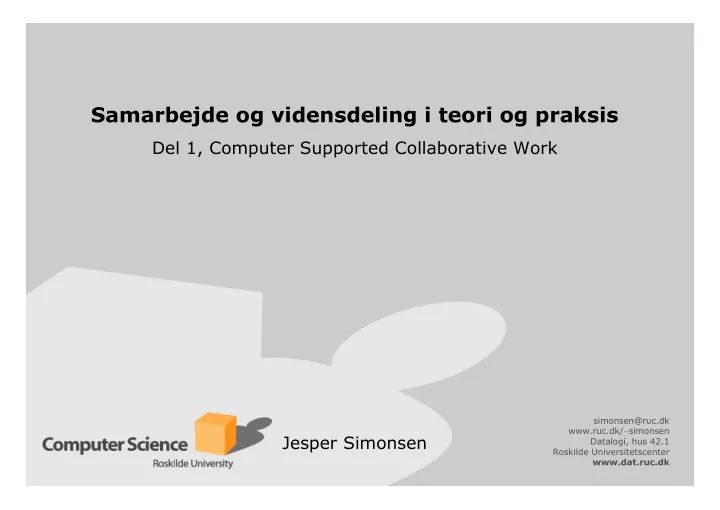

Samarbejde og vidensdeling i teori og praksis Del 1, Computer Supported Collaborative Work simonsen@ruc.dk www.ruc.dk/ ~ simonsen Jesper Simonsen Datalogi, hus 42.1 Roskilde Universitetscenter www.dat.ruc.dk
Plan for del 1 og del 2 Del 1 (i dag) • CSCW • Opponentoplæg: Analyse af kommunale hjemmesider • 2 artikler om CSCW og elektronisk patientjournal: Ellingsen, G. (2003):Coordinating work in hospitals through a global tool: • Implications for the implementation of electronic patient records in hospitals, SJIS Hartswood et al. (2003): Making a Case in Medical Work: Implications for the • Electronic Medical Record, CSCW-journal Del 2 (15/10) • KM • Opponentindlæg • Kollokvie m. Signe Svenningsen (42.1): Elektronisk patientjournal og reorganisering af medicinsk praksis Jesper Simonsen Digital Forvaltning. 8/10 2003 2
Udgangspunkt og pointe • Resultater fra DIWA forskningsprogrammet (www.diwa.dk) Megen distribution • Lidt interaktion • • CSCW og KM litteratur kan belyse dette • CSCW i Digital forvaltning (til reduktion af kompleksitet i koordinering): Oplagt strategi internt i forvaltningen • Større udfordning mht. interaktion med borgerne • Jesper Simonsen Digital Forvaltning. 8/10 2003 3
CSCW - or What’s in a Name? Grudin, (1994b) Jesper Simonsen Digital Forvaltning. 8/10 2003 4
Centrale begreber • CW: Cooperative/collaborative work, samarbejde “[P]eople engage in cooperative work when they are mutually dependent in their work and therefore are required to cooperate in order to get the work done” (Schmidt and Bannon, 1992, p. 13). • Work, arbejde vs. Articulation work, samordning “[C]arrying through a course of action despite local contingencies, unanticipated glitches, incommensurable opinions and beliefs, or inadequate knowledge of local circumstances […] Articulation resolves these inconsistencies by packaging a compromise that ‘gets the job done’” (Gerson and Star, 1986, p. 266). “Articulation work arises as a integral part of cooperative work as a set of activities required to manage the distributed nature of cooperative work […] Articulation work amounts to the following: First, the meshing of the often numerous tasks, clusters of tasks, and segments of the total arc. Second, the meshing of efforts of various unit-workers (individuals, departments, etc.). Third, the meshing of actors with their various types of work and implicated tasks.” (Schmidt and Bannon, 1992, pp. 18f.) “articulation work is constituted by the need to restrain the distributed nature of complexly interdependent activities.” (Schmidt and Simone, 1996, Proposition 1)
Motivation for CSCW i digital forvaltning • Ambitionen om at udnytte teknologien til at øge samarbejdet til at løse opgaver (på måder) som ellers ikke er muligt Løse mere komplekse opgaver • Rationalisere/effektivisere • Sammenhængende patientforløb • Fælles basisjournal på tværs af sektorer, hospitaler, specialer, • faggrupper Tværfaglighed, standardiseret terminologi og begreber • (Kirsten Bredegaard’s oplæg om EPJ) • “[A]ffording an increase in complexity of the work practice without a simultaneous increase in complexity in individual interactions” (Berg 1999, p. 391). • Fokus: CSCW til reduktion af kompleksitet i articulation work Jesper Simonsen Digital Forvaltning. 8/10 2003 6
Centrale begreber (2) • Coordination mechanism, artifact, protocol PROPOSITION 3 [behov]: In cooperative work settings characterized by complex task interdependencies, the articulation of the distributed activities requires specialized artifacts which, in the context of a set of conventions and procedures, are instrumental in reducing the complexity of articulation work and in alleviating the need for ad hoc deliberation and negotiation. (Schmidt and Simone, 1996, p. 162) PROPOSITION 4 [definition]: A coordination mechanism is a construct consisting of a coordinative protocol (an integrated set of procedures and conventions stipulating the articulation of interdependent distributed activities) on the one hand and on the other hand an artifact (a permanent symbolic construct) in which the protocol is objectified. (ibid, pp. 165f.) PROPOSITION 5 [formål]: A coordinative protocol is a resource for situated action [(Suchman, 1986)] in that it reduces the complexity of articulating cooperative work by providing a precomputation of task interdependencies which actors, for all practical purposes, can rely on to reduce the space of possibilities by identifying a valid and yet limited set of options for coordinative action in any given situation. (ibid, p. 174) Jesper Simonsen Digital Forvaltning. 8/10 2003 7
Pointe - og diskussion • CSCW i Digital forvaltning (til reduktion af komplexitet i koordinering): Oplagt strategi internt i forvaltningen • Større udfordning mht. interaktion med borgerne • THE “MISSING” – og den mest kritiske - PROPOSITION (13.5): “An artifact only conveys stipulations within a certain social context, within a certain community, in which the protocol and any change to the state of the protocol have a (more or less) certain and agreed to meaning and that it only does so under conditions of social accountability” (ibid, p. 180). Eksempler på CSCW i digital forvaltning? Jesper Simonsen Digital Forvaltning. 8/10 2003 8
Referencer • Berg, M. (1999). Accumulating and Coordinating: Occasions for Information Technologies in Medical Work. Computer Supported Cooperative Work 8, 373–401. • Bowker, G. C., and Star, S. L. (2000). Sorting Things Out. Classification and its Consequenses . MIT Press, Cambridge, Massachusetts. • Gerson, and Star, S. L. (1986). Analyzing due process in the workplace. ACM Transactions on Office Information Systems 4, 257-270. • Grudin, J. (1994a). Groupware and social dynamics: Eight challenges for developers. Communications of the ACM 37, 92-105. • Grudin, J. (1994b). CSCW: History and Focus. IEEE Computer 27, 19-26. • Pors, J. K., and Simonsen, J. (2003). Coordinating Work with Groupware: The Challenge of Integrating Protocol and Artefact. Proceedings of IFIP WG 8.2 & WG 9.4: IS Perspectives and Challenges in the Context of Globalization , 15.-17. June 2003, Athens, Greek, 2003. • Schmidt, K., and Bannon, L. (1992). Taking CSCW Seriously: Supporting Articulation Work. Computer Supported Cooperative Work (CSCW): An International Journal 1, 7-40. • Schmidt, K., and Simone, C. (1996). Coordination mechanisms: Towards a Conceptual Foundation of CSCW Systems Design. Computer Supported Cooperative Work. The Journal of Collaborative Computing 5, 155-200. • Suchman, L. A. (1987). Plans and Situated Actions: The Problem of Human-Machine Communication . Cambridge University Press, Cambridge, New York. Jesper Simonsen Digital Forvaltning. 8/10 2003 9
Recommend
More recommend